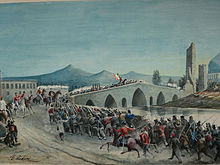
The Church of Saint Francis Xavier is a Baroque church of Palermo. It is located on the Street of the same name in the quarter of the Albergaria, within the historic centre of Palermo. The building is considered the masterpiece of the Jesuit architect Angelo Italia.

Saint George of the Genoese is a Renaissance-style, Roman Catholic church located near the port of La Cala, on Via Buon Pastore in the ancient quarter of the Loggia, in Palermo, region of Sicily, Italy.
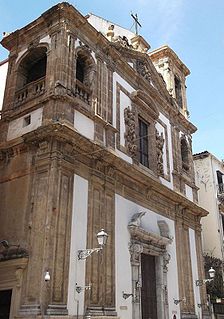
The Church of Saint Ursula of the Blacks is a Baroque-style, Roman Catholic church located in the central Via Maqueda #110, adjacent to the Palazzo Comitini, in the quarter of the Albergaria, within the historic centre of Palermo, Region of Sicily, Italy.

Porta Nuova is a monumental city gate of Palermo. It represents the entrance of the Cassaro from Corso Calatafimi and is located beside Palazzo dei Normanni, royal palace of Palermo. The gate was built to celebrate Charles V's conquest of Tunis (1535) and his visit to the capital of the Kingdom of Sicily.
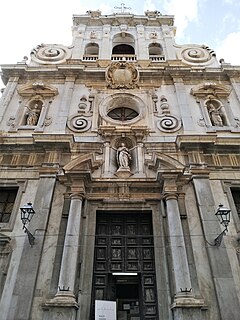
The Church of Saint Matthew is a Baroque-style, Roman Catholic church of Palermo, region of Sicily, Italy. It is located in the main street of the city, the ancient Cassaro now Corso Vittorio Emanuele, in the quarter of the Loggia, about a block east of the Quattro Canti, within the historic centre of Palermo.

The Church of Most Holy Saviour is a Baroque-style, Roman Catholic church located on #396 of the ancient main street of the Palermo, the Cassaro, presently Via Vittorio Emanuele, in the ancient quarter of the Albergaria of the city of Palermo, region of Sicily, Italy.
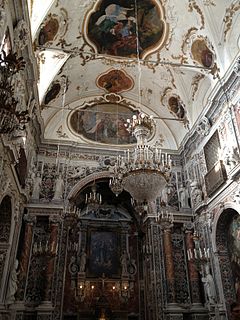
The Church of the Immaculate Conception is a Baroque church of Palermo. It is located on the busy streets composing the markets of the Capo, in the quarter of the Seralcadio, within the historic centre of Palermo.
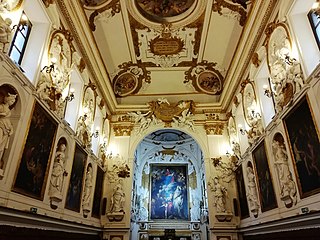
The Oratory of the Rosary of Saint Dominic is a Baroque oratory of Palermo. It is located near the Church of Saint Dominic, in the quarter of the Loggia, within the historic centre of Palermo.
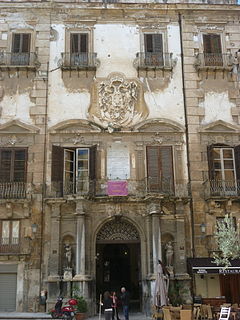
The Palazzo Alliata di Villafranca is former aristocratic mansion, now converted into a museum, located just off Via Vittorio Emanuele facing the Piazza Bologni which opens two blocks west of the Quattro Canti intersection, in the ancient quarter of the Albergaria of the city of Palermo, region of Sicily, Italy.

Simone De Wobreck was a 16th-century Flemish painter, whose known works all come from his long period in Sicily.

Andrea Carrera or Carreca was an Italian Baroque painter mainly active in Sicily. He was born in Trapani and died in Palermo.
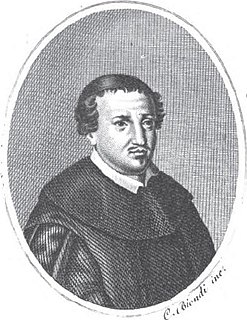
Paolo Amato was an Italian Baroque and Rococo architect. He is also notable as author of the treatise La Nuova Pratica di Prospettiva, published in Palermo in 1732.
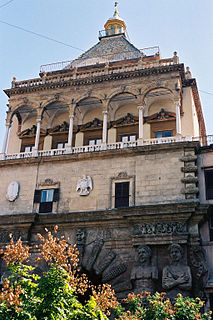
Gaspare Guercio was an Italian artist, nicknamed 'Guercio' and a major proponent of the Sicilian Baroque. He was principally a sculptor but also a designer of decorative schemes for architectural projects. He collaborated with his pupil Gaspare Serpotta, father of the more famous Giacomo Serpotta.

Santa Maria di Gesù (Italian) is a Baroque, Roman Catholic parish church in Palermo, region of Sicily, Italy. It faces piazza Beati Paoli al Capo in the Capo quarter.
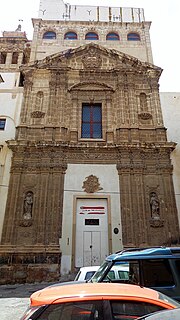
Santa Maria delle Grazie di Montevergine is a Baroque deconsecrated church of Palermo, region of Sicily, Italy. It is located on piazetta Montervergini. The church now functions as a theater: Teatro Nuovo Montevergini.
The Palazzo Filangeri-Cutò is a Baroque-style aristocratic palace located on via Maqueda 26 in the ancient quarter of Albergheria of central Palermo, region of Sicily, Italy. Once the urban palace of a wealthy and prominent family, since the 19th-century the palace has been subdivided into numerous apartments and businesses, and in dire need of restoration.

The Palazzo Celestri di Santacroce, also known as the Palazzo Sant'Elia is a Baroque-style aristocratic palace located on via Maqueda 90 in the ancient quarter of Kalsa of central Palermo, region of Sicily, Italy. Once the urban palace of a wealthy and prominent family, a large portion of the palace is now used for exhibitions and private functions. The palace is diagonal to the Southeast of the Palazzo Comitini, and just a block north of the church of the Assunta.

The Oratorio della Carità di San Pietro is a Baroque chapel or prayer room located on Via Maqueda #206, adjacent to the church of Santa Ninfa dei Crociferi, in the ancient quarter of Seralcadi of Palermo, region of Sicily, Italy.

Madonna dei Rimedi is a Baroque-style, Roman Catholic Sanctuary-church, established and still affiliated with the Discalced Carmelite order, located on Piazza Indipendenza # 9, in Palermo, region of Sicily, Italy.


